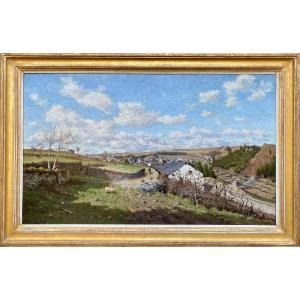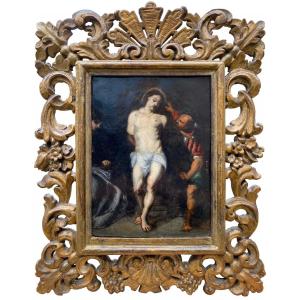Brussels 1867 – 1943
Belgian Painter
A View of Diksmuide
Signature: Signed bottom left, placed Dicsmuide and dated 1900
Medium: Oil on canvas
Dimensions: Image size 55,50 x 71 cm, frame size 68,50 x 84 cm
Biography: Gilsoul Victor Olivier was born in Brussels on September 10, in 1867.
He was a Belgian impressionist painter of landscapes, marines, harbour scenes, architectures, interiors, city and canal views, portraits and figures. He was also a watercolourist.
Gilsoul studied at the Antwerp Academy of Fine Arts with the famed master teachers and artists François Courtens (1854 – 1895) and Louis Artan (1837 – 1890).
In 1882 he won his first prize at the Academy and in 1884 debuted at the Brussels Salon. He studied also at the Brussels Academy of Fine Arts, where he won a prize (1885-1890).
Gilsoul was member of the group ‘Voorwaerts’ in 1891. He was awarded a silver medal at the Paris World Fair in 1900. In the same year, King Leopold II commissioned several compositions for his yacht “Alberta” and knighted him to the Order of King of the Belgians.
The painter stayed from 1911 in Paris, where he often painted the Versailles region, also worked and lived for some time in Brittany. He had several exhibitions in France.
He was a teacher at the Antwerp Higher Institute of Fine Arts (1924-1930) and a member and honorary member of La Gravure Originale Belge (1928).
Gilsoul painted at the Belgian coast, in Brabant (the Netherlands). In Belgium, he painted chiefly landscapes around Bruges, Ieper, Diksmuide, Nieuwpoort, as he was attracted by the mirroring waters of the North Sea, the many canals in that region and the warm, glowing colours. He also liked nocturnal faces by moonlight. He influenced a large number of painters, such as Charles Lebon (1906 – 1957).
Before 1900, his palette was dark and heavy, but under the influence of open-air painting, it became progressively brighter. His gloomy palette slowly matured around 1900. About this time, his art changed from being sombre to luminous and its colour became more distinguished.
Gilsoul’s paintings can be found in important public and private collections worldwide, in Brussels (Musée Charlier, Musée des Beaux-Arts), Elsene, Namur, Ostend, Diksmuide, Antwerp (Museum of Fine Arts), Bruges (Museum of Fine Arts), Leuven, Saint-Josse-ten-Noode, Paris (Petit Palais, France), Barcelona (Spain), Bucharest (Romania), Dordrecht (The Netherlands), Krefeld (Germany) and Luxembourg.
In Brussels Museum: “November Evening in Dordrecht” and “Becalmed in the Channel”. There is a quite a big oil painting of “Stormy Weather in Nieuwpoort” in Antwerp Museum. In Bruges Museum: “Farriers Gate, Bruges” (1905). In Brussels Town Hall: “The Three Fountains Canal”.
“No doubt V. Gilsoul is, in general, too exclusively a painter to add his soul to nature”, remarked Sander Pierron in 1904. “He is a lyricist, not an elegist”.
Literature: W.G. FLIPPO, ‘Lexicon of the Belgian Romantic painters’, Antwerp 1981.




































 Le Magazine de PROANTIC
Le Magazine de PROANTIC TRÉSORS Magazine
TRÉSORS Magazine Rivista Artiquariato
Rivista Artiquariato